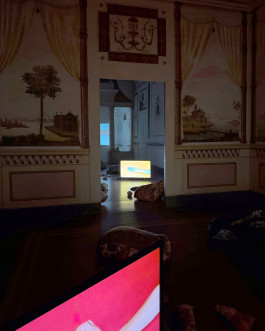
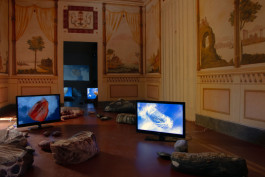
Pedrada
Biennal B. Es Baluard Museu y Consell de Mallorca.
Comisariada por Pilar Rubí.
Can Gelabert, Binissalem, juliol 2025.
Dibujos, esculturas, y video instalación 7 minutos
Cada año en el aeropuerto de Menorca se requisa una tonelada de piedras y arena del equipaje de mano de turistas que quieren llevarse un recuerdo de la isla. Parte del pequeño expolio es bloqueado, otra gran parte, seguramente superior en cantidad, se expolia dentro del equipaje embarcado.
Pedrada
Biennial B. Es Baluard Museum and Consell de Mallorca.
Curated by Pilar Rubí.
Can Gelabert, Binissalem, July 2025.
Drawings, sculptures, and video installation (7 minutes)
Every year at the airport of Menorca a ton of stones and sand is taken from the hand luggage of tourists who want to take a souvenir of the island. Part of the small spoliation is blocked, another large part, surely superior in quantity, is spoliated inside the embarked luggage.
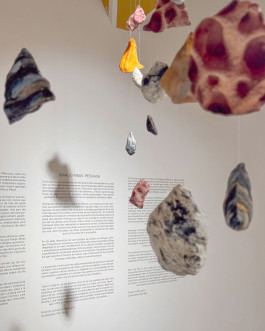
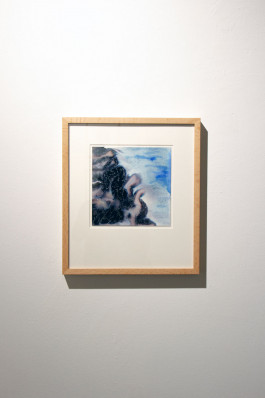
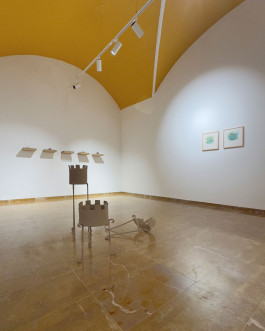
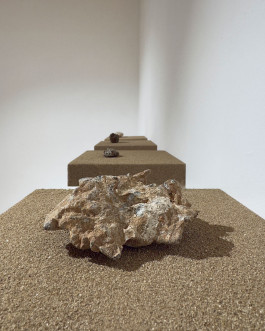
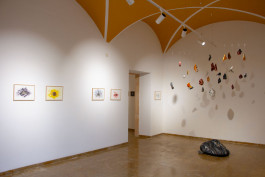
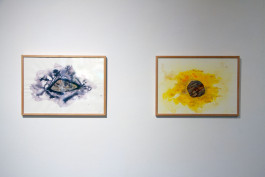
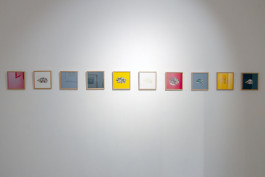
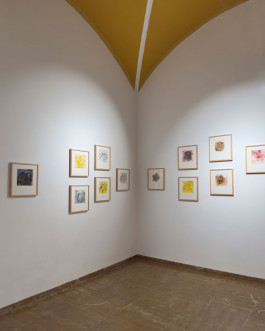
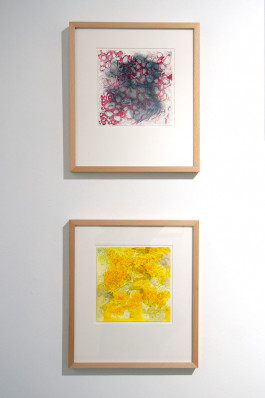
Pedrada
Art i Contemporaneïtat a Menorca . Hauser & Wirth and IME.
Sala Sant Antoni, Maó, mayo 2025.
Video instalación 7 minutos
Pedrada
Art and contemporaneity in Menorca. Hauser & Wirth and IME.
Sala Sant Antoni, Maó, May 2025.
Installation video 7 minutes

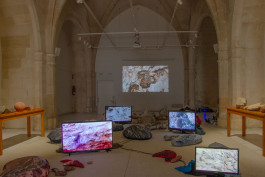
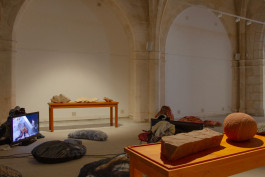
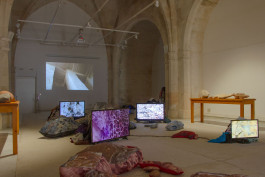
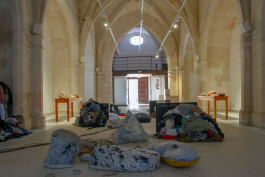
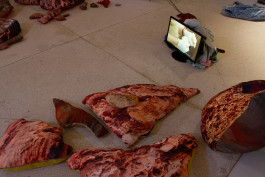
La exposición se enmarca en el programa ‘Menorca y la geología. 100 años del nacimiento de Benet Mercadal', y es el resultado de la II Ayuda Art y Contemporaneidad en Menorca, organizado por el Instituto Menorquín de Estudios, en colaboración con Hauser & Wirth y con el apoyo del Ayuntamiento de Maó.
The exhibition is part of the program 'Menorca and geology. 100 years of the birth of Benet Mercadal', and is the result of the II Art and Contemporaneity Grant in Menorca, organized by the Institut Menorquí d'Estudis, in collaboration with Hauser & Wirth and with the support of the Maó City Council.
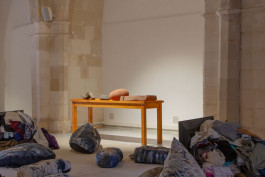
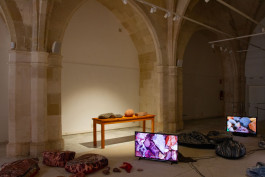
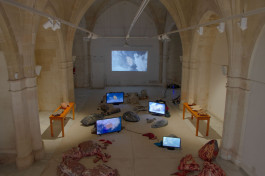
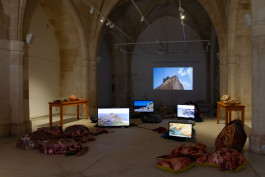
Esta iniciativa de la Conselleria de Mediambient se inició en 2013, con la colaboración de Aena, que se encarga de escanear el equipaje y decomisar las piedras, y de Mestral, una entidad de carácter social, que lleva a cabo de la catalogación del material geológico según sus características. En Menorca hay 5 tipos de paisaje dependiendo de su era geológica: blanca, amarilla, roja, gris y oscura. Una vez catalogadas, las piedras son devueltas a su correspondiente lugar. Cada pantalla corresponde a un tipo de paisaje.
Mestral es una organización que depende de Caritas. Cuando empecé con la producción del proyecto y fui a pedir permiso para grabar la clasificación de las piedras a final de temporada, me comentaron que esta tonelada era insignificante en relación con las 300 toneladas que gestionaban de residuo textil de forma anual en Menorca. Parte de la ropa que gestionan la vuelven a vender en sus tiendas, otra parte la transforman en nuevos tejidos y otra parte es residuo.
Los residuos son vendidos y gestionados por otras empresas, algunos de esos textiles después de hacer un largo viaje, en ocasiones acaban en vertederos del sur global, en playas de Ghana, Namibia, Bangladés o India. Este colonialismo textil hace que la ropa que desechamos los del norte sustituya la roca y arena de otras costas.
Las esculturas textiles están realizadas a partir de los patrones e imágenes de las piedras recuperadas en la temporada 2024, y están rellenas de los textiles que la misma entidad ya ha considerado desecho.
En 1994 se realizó la exposición Piedras de Menorca en la Biblioteca de Maó, organizada por Antoni Obrador, Miquel Fernández y Josep Florit. Las piedras de las mesas son una selección de las expuestas en 1994, y las voces masculinas del vídeo son las de los organizadores de esa muestra.
La pieza sonora es una creación de Joana Gomila y Laia Vallès.
This initiative of the Ministry of the Environment started in 2013, with the collaboration of Aena, which is in charge of scanning the luggage and seizing the stones, and Mestral, a social entity, which carries out the cataloguing of the geological material according to its characteristics. In Menorca there are 5 types of landscape depending on their geological age: white, yellow, red, gray and dark. Once catalogued, the stones are returned to their corresponding place. Each screen corresponds to a type of landscape.
Mestral is an organization that depends on Caritas. When I started with the production of the project and went to ask permission to record the classification of the stones at the end of the season, they told me that this ton was insignificant, in relation to the 300 tons of textile waste they manage annually in Menorca. Part of the clothing they manage is re-sold in their stores, some is transformed into new fabrics and some is waste.
The waste is sold and managed by other companies, some of these textiles after making a long journey, sometimes end up in landfills in the global south, on the beaches of Ghana, Namibia, Bangladesh or India. This textile colonialism means that the clothes discarded by those of us in the North replace the rock and sand of other coasts.
The textile sculptures are made from the patterns and images of the stones recovered in the 2024 season, and are filled with textiles that the same entity has already considered waste.
In 1994, the exhibition Piedras de Menorca was held at the Maó Library, organized by Antoni Obrador, Miquel Fernandez and Josep Florit. The stones on the tables are a selection from the 1994 exhibition, and the male voices in the video are from the organizers of that exhibition.
The sound piece is a creation of Joana Gomila and Laia Vallès.
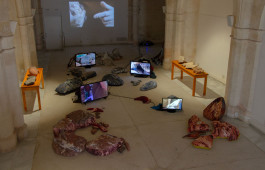
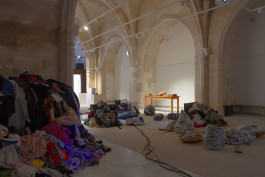
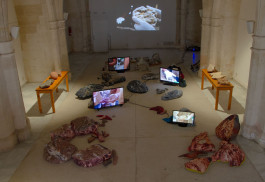
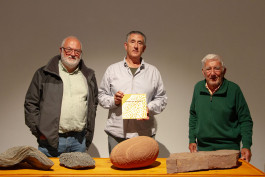
Josep Florit, Miquel Fernández y Antoni Obrador organizadores de la exposición Piedras de Menorca de 1994 y algunas de las piedras expuestas en 1994 y 2025.
Josep Florit, Miquel Fernández and Antoni Obrador, organizers of the 1994 Piedras de Menorca exhibition and some of the stones exhibited in 1994 and 2025.